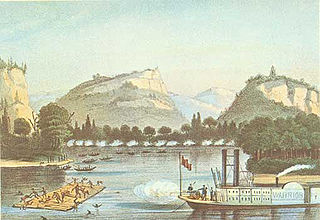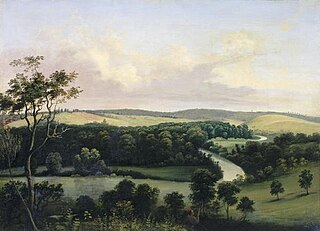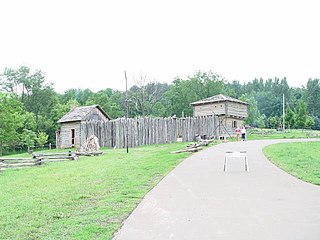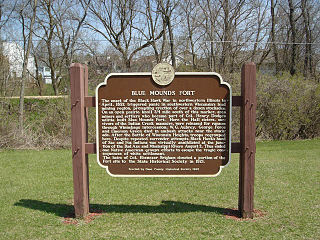
Fort Koshkonong was a military fort located near the present-day city of Fort Atkinson, Wisconsin. Intended to control the confluence of the Bark and Rock rivers, it was used as a station for local militia units and the U.S. regulars in the region to scout the British Band, a group of Native Americans who fought against government units during the 1832 Black Hawk War. General Henry Atkinson was the commander of the fort during the war. Black Hawk was in the same general area, but evaded capture and started to flee towards the Wisconsin River. The original fort was abandoned by the Army following the conflict. Local settlers dismantled it for the wood as the town developed.
Fort Jackson may refer to several places or things:

The Battle of Bad Axe, also known as the Bad Axe Massacre, was a battle between Sauk (Sac) and Fox Indians and United States Army regulars and militia that occurred on 1–2 August 1832. This final battle of the Black Hawk War took place near present-day Victory, Wisconsin in the United States. It marked the end of the war between white settlers and militia in Illinois and Michigan Territory, and the Sauk and Fox tribes under warrior Black Hawk.

Fort Armstrong (1816–1836), was one of a chain of western frontier defenses which the United States erected after the War of 1812. It was located at the foot of Rock Island, Illinois, in the Mississippi River near the present-day Quad Cities of Illinois and Iowa. It was five miles from the principal Sac and Fox village on Rock River in Illinois. Of stone and timber construction, 300 feet square, the fort was begun in May 1816 and completed the following year. In 1832, the U.S. Army used the fort as a military headquarters during the Black Hawk War. It was normally garrisoned by two companies of United States Army regulars. With the pacification of the Indian threat in Illinois, the U.S. Government ceased operations at Fort Armstrong and the U.S. Army abandoned the frontier fort in 1836.

The Battle of Horseshoe Bend, also referred to as the Battle of Pecatonica and the Battle of Bloody Lake, was fought on June 16, 1832 in present-day Wisconsin at an oxbow lake known as "Horseshoe Bend", which was formed by a change in course of the Pecatonica River. The battle was a major turning point in the Black Hawk War, despite being of only minor military significance. The small victory won by the U.S. militia at Horseshoe Bend helped restore public confidence in the volunteer force following an embarrassing defeat at Stillman's Run. The Battle of Horseshoe Bend ended with three militia men killed in action and a party of eleven Kickapoo warriors dead.

The Spafford Farm massacre, also referred to as the Wayne massacre, was an attack upon U.S. militia and civilians that occurred as part of the Black Hawk War near present-day South Wayne, Wisconsin. Spafford Farm was settled in 1830 by Omri Spafford and his partner Francis Spencer.

The Battle of Apple River Fort, occurred on the late afternoon of June 24, 1832 at the Apple River Fort, near present-day Elizabeth, Illinois, when Black Hawk and 200 of his "British Band" of Sauk and Fox were surprised by a group of four messengers en route from Galena, Illinois. One of the couriers was wounded in the thigh as the riders quickly made for the protection of the nearby stockade. Courier Fred Dixon rode ahead to warn some 70 settlers of the approaching Sauk and Fox, thus saving their lives.The small company of militia at the fort, about 28-30 men and boys led by Captain Clack Stone, fought off Black Hawk's 150-man war party in an action that lasted about an hour. The withering pace of the gunfire eventually convinced Black Hawk that the fort was too heavily defended to lead a direct attack. He considered burning the fort, then switched to raiding cabins of foodstuffs, clothing and cooking utensils. In the gathering darkness, Black Hawk and his war party retreated.

The attacks at Fort Blue Mounds were two separate incidents which occurred on June 6 and 20, 1832, as part of the Black Hawk War. In the first incident, area residents attributed the killing of a miner to a band of Ho-Chunk warriors, and concluded that more Ho-Chunk planned to join Black Hawk in his war against white settlers. The second incident occurred east of the fort as a Sauk raiding party, estimated by eyewitnesses to be as large as 100 warriors, attacked two militiamen who were investigating noises heard the night before. Two members of the militia stationed at Blue Mounds were killed in the attack, and both their bodies were badly mutilated.
The Sinsinawa Mound raid occurred on June 29, 1832, near the Sinsinawa mining settlement in Michigan Territory. This incident, part of the Black Hawk War, resulted in the deaths of two men; a third man survived by seeking cover in a nearby blockhouse. In the aftermath of the raid, Captain James W. Stephenson set out to pursue the attackers—a straggling band of Sauk Native Americans—but lost their trail at the Mississippi River. The attack occurred in the same week as other skirmishes and raids, and as a result helped contribute to the growing fear in the region. The raid caused the residents of nearby Platteville to consider fleeing their settlement.

Apple River Fort, today known as the Apple River Fort State Historic Site, was one of many frontier forts hastily completed by settlers in northern Illinois and southern Wisconsin following the onset of the 1832 Black Hawk War. Located in present-day Elizabeth, Illinois, United States, the fort at the Apple River settlement was built in less than a week. It was one of the few forts attacked during the war and the only one attacked by a band led by Black Hawk himself. At the Battle of Apple River Fort, a firefight of about an hour ensued, with Black Hawk's forces eventually withdrawing. The fort suffered one militia man killed in action, and another wounded. After the war, the fort stood until 1847, being occupied by squatters before being sold to a private property owner who dismantled the building.

James McGowan Strode (1804–1857/60) was a militia officer and politician from the U.S. state of Illinois. He served in the Illinois militia during the Winnebago War and the Black Hawk War. Strode, originally from Tennessee, lived much of his life in Galena, Illinois. In Galena, during the Black Hawk War he was given command of the 27th Regiment of the Illinois militia and oversaw the construction of a fort in that city. Strode was involved in combat during the war at the infamous Battle of Stillman's Run. In 1835 Strode was elected to represent much of the region of Illinois north of Peoria in the Illinois State Senate.

The Wisconsin Heights Battlefield is an area in Dane County, Wisconsin where the penultimate battle of the 1832 Black Hawk War occurred. The conflict was fought between the Illinois and Michigan Territory militias and Sauk chief Black Hawk and his band of warriors, who were fleeing their homeland following the Fox Wars. The Wisconsin Heights Battlefield is the only intact battle site from the Indian Wars in the U.S. Midwest. Today, the battlefield is managed and preserved by the state of Wisconsin as part of the Lower Wisconsin State Riverway. In 2002, it was listed on the U.S. National Register of Historic Places.
William Stephen Hamilton, a son of Alexander Hamilton and Elizabeth Schuyler Hamilton, was an American politician and miner who lived much of his life in the U.S. state of Illinois and territorial Wisconsin. Hamilton was born in New York, where he attended the United States Military Academy before he resigned and moved to Illinois in 1817. In Illinois he lived in Springfield and Peoria and eventually migrated to the lead-mining region of southern Wisconsin and established Hamilton's Diggings at present-day Wiota. Hamilton served in various political offices and as a commander in two Midwest Indian Wars. In 1849 he moved to California on the heels of the California Gold Rush. He died in Sacramento, most likely of cholera, in October 1850.
After the outbreak of the Black Hawk War, at the Battle of Stillman's Run in May 1832, there were minor attacks and skirmishes throughout the duration of the conflict. The war was fought between white settlers in Illinois and present-day Wisconsin and Sauk Chief Black Hawk. The relatively minor attacks of the war were widely dispersed and often carried out by bands of Native Americans that were unaffiliated with Black Hawk's British Band.

Warrior was a privately owned and constructed steamboat that was pressed into service by the U.S. government during the Black Hawk War to assist with military operations. Warrior was constructed and launched in 1832 at Pittsburgh, Pennsylvania by Joseph Throckmorton who also served as the vessel's captain. Once constructed the vessel traveled to St. Louis and into the war zone. Warrior played a key role in the decisive Battle of Bad Axe. Following the war the steamboat continued its service under Throckmorton along the Upper Mississippi River.
Clack Stone was the elected captain of the “Apple River“ Company, 27th Regiment Illinois Militia during the Black Hawk War of 1832. He was in charge of a company mustered into service in May 1832 from Jo Daviess County, Illinois. Stone’s company manned Apple River Fort, a log stockade and blockhouse— a reconstruction of which is located on knoll just east of present-day Elizabeth Stone provided leadership during two war-related incidents. In the first event, some horses were stolen from the fort during the night of June 17, in the prelude to the June 18 action known then as “Stephenson’s Fight.” Today, the fight is erroneously known as the Battle of Waddams Grove. The second event was on the afternoon of June 24: an intense battle known as the Battle of Apple River Fort. After the war, Stone built and operated a general store and helped Redding Bennett, John D. Winters, and others survey and lay out lot lines for the proposed village of Elizabeth. He also owned and apparently operated for a time the “Eagle Saloon” in Galena.
Stone laid claim to numerous land parcels located west of the present village. He remained in today’s Jo Daviess County with his common law wife Delilah Hickman for several years, then moved south to Union Grove in what is now Carroll County, Illinois.

Fort Union was a frontier fort at Dodgeville, Wisconsin, United States, during the 1832 Black Hawk War. It served as military commander Henry Dodge's headquarters during that war.
Fort Jackson was a frontier fort located in Mineral Point, Michigan Territory, and constructed during the 1832 Black Hawk War.
Fort Hamilton is a historic fort in Brooklyn, New York, US.















